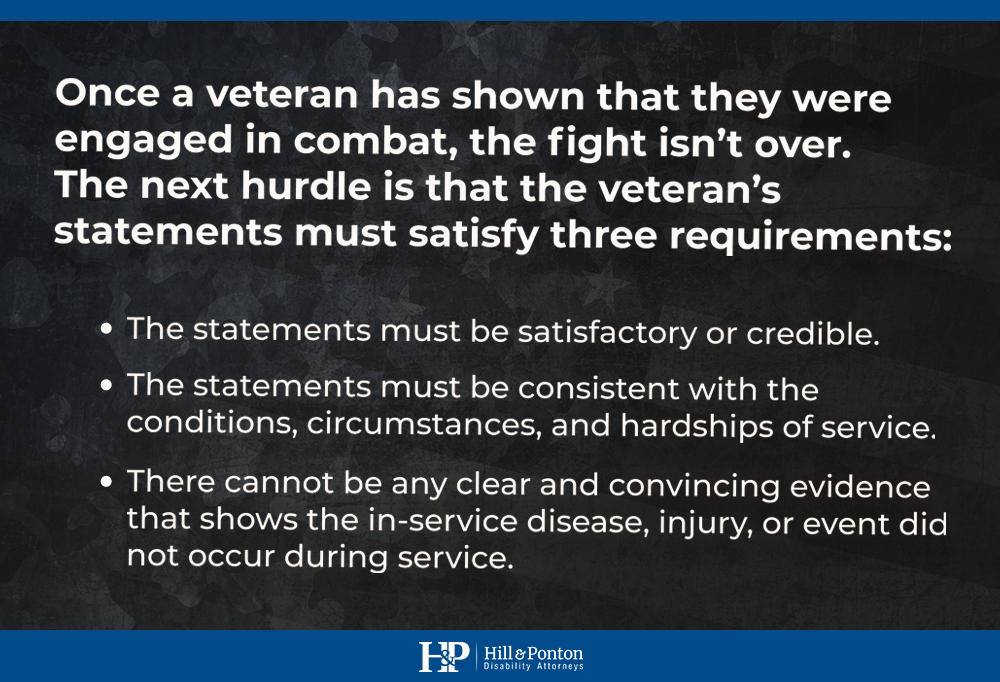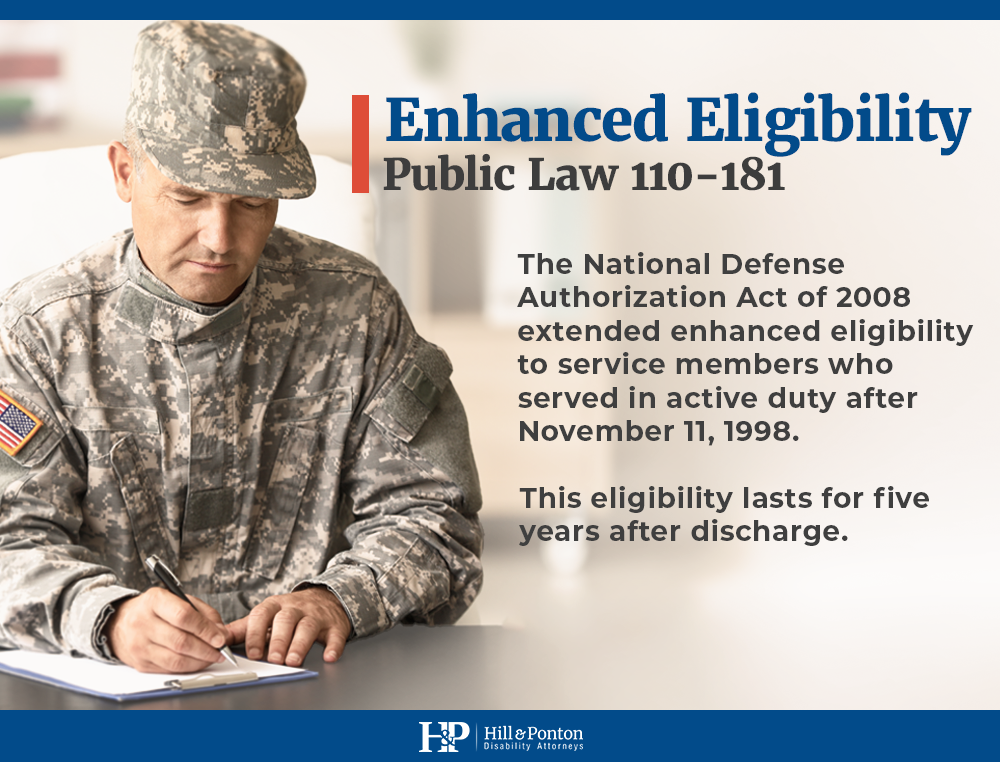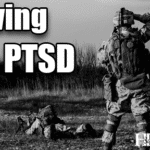Combat veterans are typically given a little more leeway when it comes to submitting a VA disability claim for veterans benefits and having to prove they were in combat.
The reason is usually because records were oftentimes not well documented in combat situations. And, even if the records were made, they may not have been complete nor always accurate.
Recognizing this, Congress created a law contained in 38 USC § 1154(b).
This statue states that for any veteran who engaged in combat with the enemy, the VA shall:
“accept as sufficient proof of service-connection of any disease or injury alleged to have been incurred in or aggravated by such service satisfactory lay or other evidence of service incurrence or aggravation of such injury or disease, if consistent with the circumstances, conditions, or hardships of such service…”
What is a Combat Veteran?
Combat Veterans are individuals who served in a conflict zone while in the military. There are certain laws and regulations set forth to provide assistance to these veterans.
Common Types of Veterans Under This Designation:
- Operation Enduring Freedom (OEF) in Afghanistan
- Operation Iraqi Freedom (OIF)
- Operation New Dawn (OND) in Iraq
- Vietnam Veterans
Additionally, recipients of Hostile Fire Pay or Imminent Danger pay will typically qualify for combat veteran status.
These also apply to activated Reservists and members of the National Guard.
However, recipients of dishonorable discharge remain ineligible for these benefits.

How Do I Prove I’m a Combat Veteran?
Sometimes, providing enough evidence that you are a combat veteran is difficult. The VA requires multiple types of documentation to determine service in a theater of combat operations. These documents include:
- Combat veterans medals for service
- Combat veteran status after January 28, 2003
- Receipt of imminent danger or hostile fire pay or tax benefits
- Military service documentation reflecting use in combat theater
Accessing these documents may take time. You can always obtain copies for your personal records. It’s also beneficial to reference your DD-214 for the type of pay and medals that qualify you for combat service.
Eligibility for Combat-Related Special Compensation (CRSC)
CRSC affords veterans tax-free monthly compensation for veterans who are eligible and have combat-related injuries. With CRSC, veterans can receive retirement pay and VA disability compensation, if their disability is related to combat.
The following criteria must be met in order to qualify for CRSC:
- Active or Reserve component with 20 years of creditable service or medically retired.
- Receiving military retirement pay.
- Have a 10 percent or greater VA-related disability.
- Military retired pay is reduced by VA disability payments (VA Waiver).
Documents must also be submitted that proves disabilities were caused by one of the following:
- Training that simulates war
- Hazardous duty
- An instrument used in war
- Armed conflict
Providing Service Connections for Combat-Wounded Veteran Benefits
Even after providing relevant documentation, you still must connect combat-related injuries to current disabilities.

Supporting Statements
Despite the validity of a DD-214 or combat veteran metals, the VA still may challenge disability claims. There are ways to challenge this, however.
One way is by providing statements from fellow service members, proving the disability claim. These statements are also known as buddy letters or buddy statements. Any provided information must:
- Be satisfactory and credible
- Consistent with service conditions, circumstances and hardships
- Show the in-service condition or injury occurred outside service
Medical Documentation
Depending on the type of combat veteran benefits you seek, you need to supply medical documentation, too. The documentation must support the connection to combat service.
Any medical treatments, vocational reports, psychological evaluations, etc. can support your claim, and the more documentation you possess, the less likely your claim will be denied.
Types of Service Connections for Combat Veteran Benefits
Direct Service Connection
These are the most common types of claim and pertain to injuries in a theater of combat. Directly related connections are marked by a diagnosed disability at the time of the claim.
Determining a direct service connection is one of the most simple combat disability claims to prove. However, make sure you have the proper documentation to support a directly related service claim. Without documentation, the claim will be harder to validate.
Service Connection Through Aggravation
When veterans accumulate disabilities during active duty, they can worsen in particular circumstances. With service members that have pre-existing conditions, combat can aggravate these conditions, making something that might have been an inconvenience before, now a full-fledged disability and worth filing a claim for.
Presumptive Service Connection
Presumptive service connections differ from direct because they apply to specific periods of service known to impact service members. Examples of this include:
- Army or Navy veterans exposed to Agent Orange
- Air Force or Army members exposed to atomic or ionizing radiation
- Any troops from the Persian Gulf War
Secondary Service Connection
When a direct combat service disability causes a secondary disability, this connection occurs. Typically, secondary service disabilities arise years later.
Secondary service disabilities also apply to non-service related disabilities. Any physical or mental condition from non-combat scenarios can be aggravated into secondary service connection.
Combat Veterans Involved in the September 11th Attacks
Military personnel who were at the World Trade Center or the Pentagon during the terrorist attacks of September 11, 2001, are considered combat veterans.
The Department of Defense has authorized special payment to those service members for that day. If you were involved with those events and suffered long-term medical effects, you should consider including it in a VA disability claim.
Types of Combat Veteran Benefits
General Health Benefits
These benefits include cost-free care and medication for conditions related to combat service. Anticipate enrollment in Priority Group 6, unless eligible for a higher priority group. You should receive access to all of the follow benefits:
- Preventative care services
- Outpatient treatment and diagnostic services
- Inpatient treatment and diagnostic services
- Women’s healthcare services
- Long-term care services
- Additional services including transportation and medical equipment

Enhanced Eligibility Benefits
The National Defensive Authorization Act of 2008 extended the period of eligibility for those who served in theater of combat operations after November 11, 1998.
The enhanced eligibility period for enrollment in the VA health care system begins five years from the date of discharge or release for any present-day veterans. For veterans with multiple call-ups, the enrollment period begins with the most recent discharge date.
Helpful Evidence for Enhanced Eligibility
Combat Veteran Veterans can prove that they fall under this category through military service documentation that shows their service in a combat theater, proof that they received a combat service medal or campaign medal, and/or proof of receipt of imminent danger pay or hostile fire pay.
What is the difference between benefits for Combat and Non-Combat Veterans?
The most significant difference is a priority group. Veterans with combat service rank higher in priority, which means they qualify for more medical coverage and higher eligibility enrollment.
You do not have to be a combat veteran to receive VA disability. If you enlisted and served our country, in whatever capacity, you should look into VA benefits.
Where to Find Legal Support If You Are a Combat Veteran Looking for Benefits
If you are a veteran who served in a combat zone and have questions about your VA disability claim for service connection, the team at Hill & Ponton are available to help.
Equip yourself with the tools and resources you need to avoid common mistakes that delay many VA benefits claims, by downloading our FREE ebook The Road to VA Compensation Benefits.





